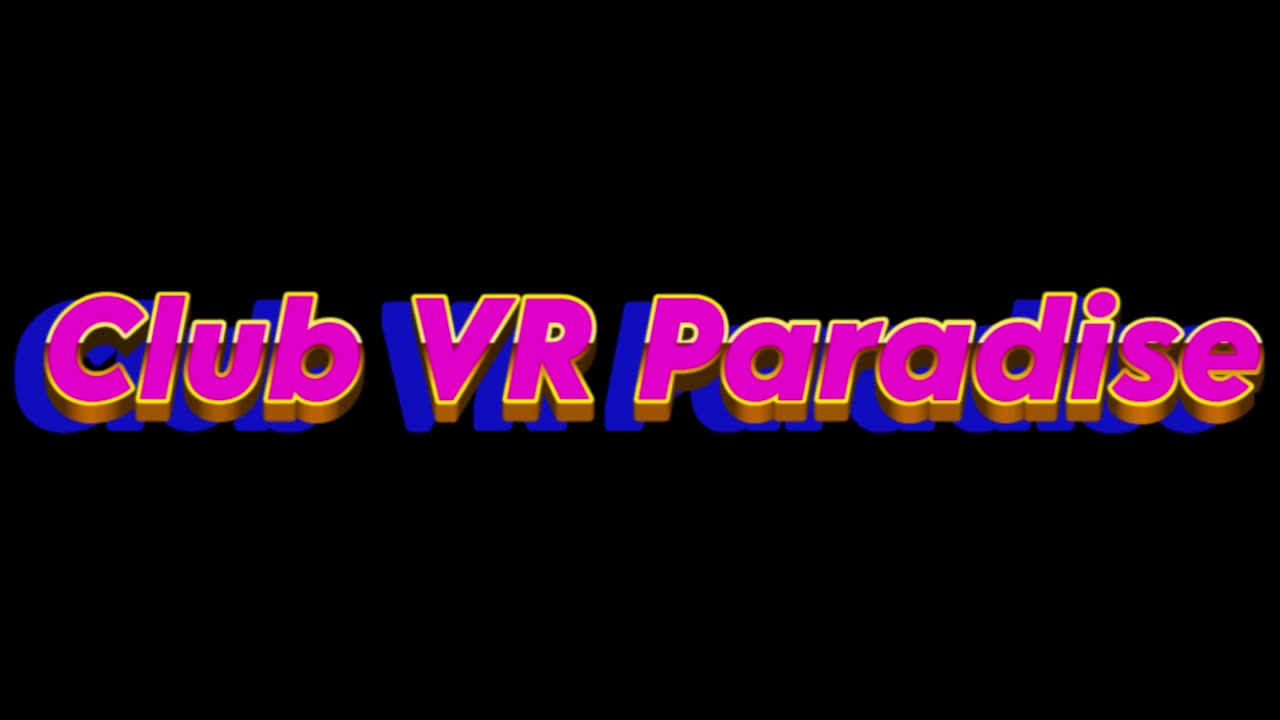Premium Only Content

Club VR Paradise Season 2 Episode 10
Club VR Paradise Season 2 Episode 10
Produced by Evil Ghandi
Paradise Princesses & the Technologies That Enabled Their Influence
Princess Archetype Era / Environment Technology / Medium Effect on Influence Signature Environmental Impact
The First Dancer Prehistoric caves Firelight, ash, charcoal, stone walls, primitive percussion Movement and gestures animate shadows, triggering perception of motion and life in static images Flickering shadows on walls; early proto-VR illusion
The Oracle Dancer Ancient Temples & Amphitheaters Reflective mosaics, water basins, bronze bells, open-air acoustics Reflections and sound amplify dancer’s presence, inducing collective trance states Visual echoes of movement; rhythmic resonance shaping audience perception
The Masked Minstrel Medieval Courts & Masquerades Mirrors, candlelight, acoustically engineered halls Creates interactive light/shadow play; enhances subtle social and psychological influence Ghostly echoes of motion, hidden gestures influencing courtly behavior
The Dramatic Virtuosa Renaissance Theater (Shakespeare) Pulley systems, rotating stages, trap doors, music-driven automata Simulates dynamic environments and narrative immersion, blending motion with story Stage transformations reacting to actors’ movement, audience emotionally engaged
The Illuminated Prima Baroque & Enlightenment Opera Chandeliers, mirrors, orchestrated multi-instrument music Synchronizes sound, lighting, and choreography; amplifies environmental control Multi-sensory immersive performance; spatially responsive audience experience
The Jazz Siren Early 20th Century Cabarets Neon lights, smoke machines, hydraulic stages, amplified sound Enhances perception of depth and dynamism; allows improvisation to shape environment Fluid light patterns, dynamic motion feedback; ephemeral yet immersive social VR analog
The Digital Muse Late 20th Century Installations CRT projectors, motion sensors, early holograms, interactive multimedia software Introduces interactive overlays and real-time responsiveness; proto-VR Motion-triggered visual projections, responsive spatial simulations
Modern Princess (Lumine Drift, Skyra Volt, Echo Veil, Vibeweaver 13, Stephanie Hammond) Club VR Paradise (2025–Present) Full VR rigs, haptic suits, spatial audio, AI-driven interactive environments Real-time environment modification, persistent holographic echoes, emergent physics Immersive interactive realms; influence over avatar motion, lighting, music, and persistent virtual objects
Future Iterations Adaptive Metaverse Neural-link VR, AI-generated adaptive worlds, quantum environment simulation Consciousness-responsive worlds; avatars shape reality itself Fully emergent, evolving VR environments; persistent echoes of all Princess influence across time
Key Insights:
1. Princess Influence Always Requires a Medium – Whether firelight, reflective surfaces, or VR rigs, each archetype needed a technology to extend presence beyond their physical body.
2. Technology Shapes Interaction – The more sophisticated the medium, the broader the influence radius and complexity of interaction.
3. Historical Continuity – Modern Club VR Paradise is the culmination of all previous technologies, blending physics, interactivity, AI, and persistent environmental memory into a single immersive ecosystem.
Metaverse Entertainment Timeline: From Arcades to Club VR Paradise
________________________________________
1970s – The Dawn of Interactive Play
• Technology: Pong, Space Invaders, early arcade cabinets
• Cultural Shift: Video games emerge as a form of entertainment focused purely on skill and fun, diverting youth from gambling and profit-driven amusements.
• Corporate Tension: Casinos view this as a threat; newspapers warn of “machines stealing minds.”
• Underlying Legacy: ProtoLink Systems, a small software company, creates the first middleware enabling data transfer between arcade machines, earning a 1% royalty on all software using this code—laying the foundation for networked entertainment.
________________________________________
1980s – The Golden Age of Arcades
• Technology: Home consoles (Atari, NES), high-score networking
• Cultural Shift: Arcades become social hubs where skill and creativity are valued over money.
• Corporate Pushback: Casinos launch media campaigns portraying gaming as a “corrupting influence” on youth.
• Legendary Event: The Arcade Riots (1983) — protests against arcade closures and vilification of gaming.
• Underlying Legacy: ProtoLink Systems’ network code enables persistent player identity and early leaderboards, shaping social gaming culture.
________________________________________
1990s – Networked Play & Expansion
• Technology: LAN parties, bulletin board systems, multiplayer PC games
• Cultural Shift: Gaming evolves into collaborative, social, and skill-based entertainment.
• Corporate Maneuver: Casinos build lavish “Neo-Casino Arcades” blending gambling and spectacle to recapture youth attention.
• Legendary Event: The Digital Divide Riots—gamers protest media campaigns vilifying games, cementing cultural legitimacy.
• Underlying Legacy: ProtoLink Systems’ royalties fund independent developers, enabling global collaboration and experimentation.
________________________________________
Early 2000s – Immersive Digital Media
• Technology: Early MMOs, motion-sensitive controllers, interactive storytelling
• Cultural Shift: Entertainment emphasizes immersion, narrative depth, and collaboration rather than monetary gain.
• Corporate Resistance: Casinos attempt VR integration in controlled environments but fail to replicate open-world freedom.
• Legendary Event: The Holo Underground — secret VR clubs and arcades allow experimental content and early motion-capture dances.
• Underlying Legacy: ProtoLink Systems’ code evolves to transfer real-time movement and environmental data, forming the foundation of interactive VR.
________________________________________
2010s – Consumer VR Emergence
• Technology: Oculus Rift, HTC Vive, haptic suits, motion capture
• Cultural Shift: VR allows fully immersive worlds; social interaction, dance, and collaboration flourish outside gambling frameworks.
• Corporate Tension: Casinos attempt to co-opt VR for profit-driven entertainment but cannot replicate the creative freedom of open VR spaces.
• Legendary Event: The first public VR social clubs emerge, including early Château VR-style venues, where avatars can perform dance and social rituals.
• Underlying Legacy: ProtoLink Systems’ connection framework enables real-time movement replication and interaction across VR environments.
________________________________________
2020s – Club VR Paradise
• Technology: Advanced haptic VR, AI-driven interactive environments, spatial audio, VibeStream broadcasting
• Cultural Shift: Immersive social spaces evolve into full Metaverse hubs; Club VR Paradise combines historical inspiration, dance, and narrative into a persistent, interactive world.
• Corporate Pushback: Casinos attempt to portray VR as socially isolating, but public adoption accelerates creative, community-driven experiences.
• Legendary Event: Founding of Club VR Paradise (2025) — E.G. (Evil Gandhi) launches a multi-environment Metaverse club where avatars and Princesses leave persistent echoes.
• Underlying Legacy: ProtoLink Systems’ original middleware underpins cross-platform VR interactions, ensuring persistent environmental effects and inter-avatar dynamics.
________________________________________
2030s – The Metaverse Expansion
• Technology: Neural-link VR, AI-generated adaptive content, quantum simulations
• Cultural Shift: Immersion becomes total; avatars, Princesses, and AI interact dynamically with human intention, creating fully responsive worlds.
• Corporate Dynamics: Casinos attempt legislation and controlled VR, but creativity-driven hubs remain autonomous.
• Legendary Event: The First Metaverse Convergence — a synchronized, multi-environment festival unites avatars, Princesses, and hidden realms, establishing enduring gameplay and lore.
• Underlying Legacy: ProtoLink Systems’ network code continues to connect virtual environments, linking avatars and data across decades of entertainment evolution.
________________________________________
2040s & Beyond – Eternal VR Legacy
• Technology: Fully adaptive consciousness-responsive environments, AI narrative engines, persistent Metaverse ecosystems
• Cultural Shift: Entertainment and social interaction merge; immersive experience becomes indistinguishable from perception.
• Corporate Conflict: Attempts to monopolize VR continue, but decentralized, creative communities thrive.
• Legendary Event: Club VR Paradise evolves into a self-sustaining Metaverse organism, preserving echoes of every previous era, every dance, and every interaction.
• Underlying Legacy: The 1% royalties from ProtoLink Systems’ middleware serve as the invisible connective tissue across all VR environments, ensuring historical continuity and interoperability of emergent experiences.
The Daily Ledger – March 14, 1984
“Arcade Madness: The New Digital Addiction Threatening Our Youth”
Byline: Horace D. Welling, Special Correspondent
Metro City, March 14 – A growing menace has taken hold of our city’s youth, and it doesn’t involve drugs, alcohol, or the familiar vices. This menace comes in the form of the colorful, blinking cabinets now appearing on every street corner: video game machines.
Once considered a harmless amusement, these “arcade games” are rapidly consuming the attention—and the time—of young citizens, with alarming effects. Reports indicate children skipping meals, ignoring homework, and abandoning outdoor recreation in favor of the hypnotic glow of the machines. Psychologists interviewed for this report warn of early signs of digital dependency, a condition they claim could have long-term consequences on cognitive development.
Industry insiders allege that these machines are deliberately engineered to exploit the natural impulses of young players, keeping them addicted with repetitive rewards and high-score incentives. “It’s like gambling without the money,” one retired casino manager commented. “They’re training the next generation to chase fleeting satisfaction, all for the entertainment of unseen operators.”
Several city council members have proposed ordinances to restrict operating hours and placement of arcades, citing the potential social hazard. Community groups are organizing “screen-free weekends” to counteract the influence of the machines.
Critics argue that the arcades may represent a broader cultural shift: a rebellion against traditional entertainment venues such as casinos, movie theaters, and social clubs, which rely on monetized experiences. “We’ve built an entertainment ecosystem over decades,” said a spokesperson for one major casino conglomerate. “Now, a new form of amusement threatens to undo it all.”
Public Reaction: Despite warnings, lines continue to form outside arcades across the city, with teenagers and young adults embracing the games as a new form of social interaction, skill development, and creative challenge.
Editorial Note: Whether this trend represents a dangerous addiction or the dawn of a new era of interactive entertainment remains to be seen. One thing is clear: the world of leisure is changing, and the old institutions of play may not survive unchallenged.
Corporate Media Archive: Big Casino Industry Narrative Against Emerging Entertainment
________________________________________
1. 1984 – Arcade Panic
Newspaper: The Daily Ledger
Headline: “Arcade Madness: The New Digital Addiction Threatening Our Youth”
Snippet:
“A growing menace has taken hold of our city’s children. Video game machines, once thought harmless, now lure young citizens into hours of hypnotic play, diverting them from studies, social life, and even outdoor activity. Experts warn of early signs of ‘digital dependency,’ a condition that could threaten the next generation’s moral and mental development.”
________________________________________
2. 1989 – Console Conspiracy
Newspaper: Metro Tribune
Headline: “Home Consoles: The Living Room Threat to Family Values”
Snippet:
“Families report that children spend entire evenings glued to blinking screens, ignoring household responsibilities. While some call this a harmless pastime, psychologists fear long-term social consequences. Critics argue that these systems erode shared family experiences, turning homes into private arcades and weakening community bonds.”
________________________________________
3. 1995 – Network Menace
Newspaper: National Evening Journal
Headline: “LAN Games Fueling a Generation of Social Recluses?”
Snippet:
“The rise of networked games and online communities has created new digital spaces where teenagers socialize—away from traditional halls, theaters, and social clubs. Parents and educators report alarming trends: isolation, neglect of real-world responsibilities, and a fascination with virtual achievement over tangible skill. Are we witnessing the slow erosion of physical social life?”
________________________________________
4. 2002 – Motion-Controlled Threat
Newspaper: Daily Herald
Headline: “Interactive Screens and the Danger of Digital Obsession”
Snippet:
“Motion-sensitive games may seem harmless, but doctors caution that excessive play can lead to repetitive strain, overstimulation, and unhealthy immersion in virtual activity. While casinos provide structured entertainment with oversight, interactive screens at home and in public arcades offer none of the safeguards necessary for proper youth development.”
________________________________________
5. 2015 – VR Villainy
Newspaper: The Urban Gazette
Headline: “Virtual Reality: Escapism or Social Collapse?”
Snippet:
“Consumer VR is rapidly entering homes, offering experiences once limited to gaming labs. While proponents tout creativity and immersion, critics warn that young players are substituting real-world achievements for virtual accolades. The lack of regulation in these spaces raises concerns over social isolation, mental fatigue, and unchecked influence.”
________________________________________
6. 2025 – Metaverse Warning
Newspaper: Metro Tech Times
Headline: “Metaverse Clubs: A Playground for Unsupervised Youth?”
Snippet:
“Virtual Metaverse clubs are redefining social spaces, but questions remain about their safety. Critics argue that immersive VR hubs could ‘reshape minds’ and disrupt traditional entertainment sectors. Advocates of structured, monetized environments—such as casino-backed VR venues—urge regulation to prevent potential social consequences and maintain oversight of these new worlds.”
Propaganda Timeline: Corporate-Controlled Headlines Against New Entertainment
________________________________________
1984 – The Arcade Panic
Source: The Daily Ledger
Headline: “Arcade Madness: The New Digital Addiction Threatening Our Youth”
• Framed arcades as a threat to children, citing “digital dependency.”
• Claimed games were teaching youths to chase ephemeral rewards, a subtle echo of gambling behavior.
• Called for ordinances and restrictions, positioning casinos as guardians of societal morality.
________________________________________
1989 – The Console Conspiracy
Source: Metro Tribune
Headline: “Home Consoles: The Living Room Threat to Family Values”
• Blamed NES and Atari systems for keeping children indoors, “turning families into passive spectators of blinking screens.”
• Expert “psychologists” warned that games were stunting social development, while ignoring creative or educational potential.
• Casinos funded front groups to promote legislation for screen-time limits, portraying themselves as protecting youth while suppressing competition.
________________________________________
1995 – The Network Menace
Source: National Evening Journal
Headline: “LAN Games Fueling a Generation of Social Recluses?”
• Highlighted the rise of networked multiplayer games and early MMOs.
• Claimed players were abandoning traditional social spaces (e.g., bowling alleys, casinos, theaters) in favor of “digital isolation.”
• Portrayed casinos as community pillars threatened by a new, uncontrolled form of interactive entertainment.
• Subtle language implied that gaming was a tool for undermining economic and social order.
________________________________________
2002 – The Motion-Controlled Threat
Source: Daily Herald
Headline: “Interactive Screens and the Danger of Digital Obsession”
• Focused on motion-sensitive games (e.g., EyeToy) and early VR prototypes.
• Framed motion-based play as a physical and psychological risk, citing anecdotal reports of repetitive strain and overstimulation.
• Casinos tried to position themselves as offering “safe, structured entertainment,” contrasting with “dangerous, uncontrolled” digital experiences.
________________________________________
2015 – VR Villainy
Source: The Urban Gazette
Headline: “Virtual Reality: Escapism or Social Collapse?”
• Portrayed consumer VR headsets as isolating, addictive, and anti-social.
• Claimed young people were substituting “real-life achievements” with virtual accomplishments.
• Highlighted VR social spaces as “ungoverned and potentially unsafe,” indirectly promoting casino-owned VR platforms as regulated alternatives.
________________________________________
2025 – The Rise of the Metaverse
Source: Metro Tech Times
Headline: “Metaverse Clubs: A Playground for Unsupervised Youth?”
• Warned that immersive VR hubs like Club VR Paradise could “reshape the minds of players” and undermine traditional entertainment industries.
• Casinos lobbied for oversight and regulation under the guise of public safety.
• Attempted to frame emergent VR worlds as threats to social cohesion, while ignoring their role as creative and collaborative platforms.
-
 21:40
21:40
Bitcoin Policy Institute
6 hours agoCongressman Warren Davidson Unveils the “Bitcoin for America Act” | Spotlight Series #1
13.4K -
 LIVE
LIVE
LFA TV
20 hours agoLIVE & BREAKING NEWS! | THURSDAY 11/20/25
1,055 watching -
 LIVE
LIVE
freecastle
8 hours agoTAKE UP YOUR CROSS- Let your eyes LOOK directly FORWARD, and your gaze be STRAIGHT before YOU!
153 watching -
 1:25:51
1:25:51
DeVory Darkins
5 hours agoDemocrats caught in corruption scheme as JD Vance issues MAJOR UPDATE
143K73 -
 1:48:48
1:48:48
MattMorseTV
6 hours ago $38.36 earned🔴Sedition Charges INBOUND.🔴WH Press Conference.🔴
58.7K164 -
 9:06
9:06
Jamesons Travels
22 hours ago $4.46 earnedMilitary Veterans in Congress Tell Troops to Refuse Trump's Orders
31.9K49 -
 1:42:47
1:42:47
The Bold Lib
3 hours agoBOLDCHAT: Unemployment | AI | Birth Rates w/ANGELA BELCAMINO
22.3K1 -
 20:34
20:34
ArynneWexler
8 hours agoNew Poll: Women Are Done With America | NN8
25.4K43 -
 59:30
59:30
The White House
6 hours agoPress Secretary Karoline Leavitt Briefs Members of the Media, Nov. 20, 2025
62.1K29 -
 2:06:37
2:06:37
Steven Crowder
8 hours agoJasmine Crockett's Epstein Idiocy & the Absolute State of the Democrat Party
603K416